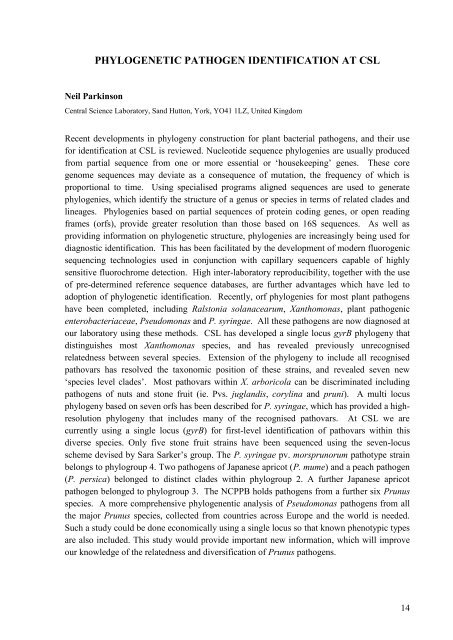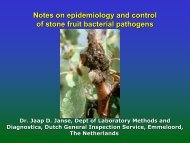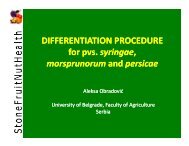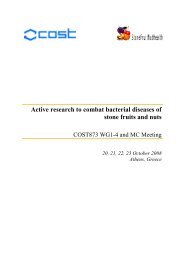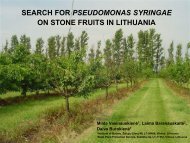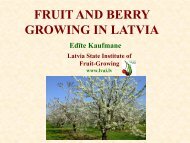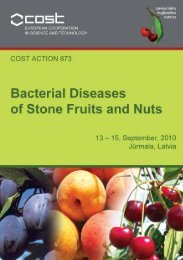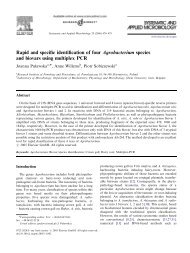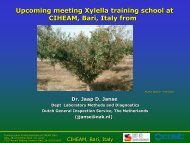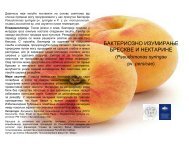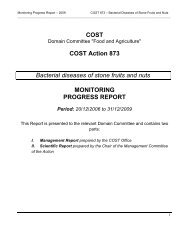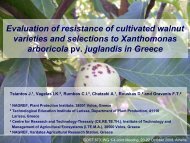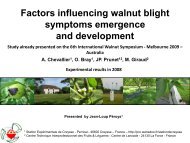Pseudomonas meeting - Cost 873
Pseudomonas meeting - Cost 873
Pseudomonas meeting - Cost 873
- No tags were found...
You also want an ePaper? Increase the reach of your titles
YUMPU automatically turns print PDFs into web optimized ePapers that Google loves.
PHYLOGENETIC PATHOGEN IDENTIFICATION AT CSLNeil ParkinsonCentral Science Laboratory, Sand Hutton, York, YO41 1LZ, United KingdomRecent developments in phylogeny construction for plant bacterial pathogens, and their usefor identification at CSL is reviewed. Nucleotide sequence phylogenies are usually producedfrom partial sequence from one or more essential or ‘housekeeping’ genes. These coregenome sequences may deviate as a consequence of mutation, the frequency of which isproportional to time. Using specialised programs aligned sequences are used to generatephylogenies, which identify the structure of a genus or species in terms of related clades andlineages. Phylogenies based on partial sequences of protein coding genes, or open readingframes (orfs), provide greater resolution than those based on 16S sequences. As well asproviding information on phylogenetic structure, phylogenies are increasingly being used fordiagnostic identification. This has been facilitated by the development of modern fluorogenicsequencing technologies used in conjunction with capillary sequencers capable of highlysensitive fluorochrome detection. High inter-laboratory reproducibility, together with the useof pre-determined reference sequence databases, are further advantages which have led toadoption of phylogenetic identification. Recently, orf phylogenies for most plant pathogenshave been completed, including Ralstonia solanacearum, Xanthomonas, plant pathogenicenterobacteriaceae, <strong>Pseudomonas</strong> and P. syringae. All these pathogens are now diagnosed atour laboratory using these methods. CSL has developed a single locus gyrB phylogeny thatdistinguishes most Xanthomonas species, and has revealed previously unrecognisedrelatedness between several species. Extension of the phylogeny to include all recognisedpathovars has resolved the taxonomic position of these strains, and revealed seven new‘species level clades’. Most pathovars within X. arboricola can be discriminated includingpathogens of nuts and stone fruit (ie. Pvs. juglandis, corylina and pruni). A multi locusphylogeny based on seven orfs has been described for P. syringae, which has provided a highresolutionphylogeny that includes many of the recognised pathovars. At CSL we arecurrently using a single locus (gyrB) for first-level identification of pathovars within thisdiverse species. Only five stone fruit strains have been sequenced using the seven-locusscheme devised by Sara Sarker’s group. The P. syringae pv. morsprunorum pathotype strainbelongs to phylogroup 4. Two pathogens of Japanese apricot (P. mume) and a peach pathogen(P. persica) belonged to distinct clades within phylogroup 2. A further Japanese apricotpathogen belonged to phylogroup 3. The NCPPB holds pathogens from a further six Prunusspecies. A more comprehensive phylogenentic analysis of <strong>Pseudomonas</strong> pathogens from allthe major Prunus species, collected from countries across Europe and the world is needed.Such a study could be done economically using a single locus so that known phenotypic typesare also included. This study would provide important new information, which will improveour knowledge of the relatedness and diversification of Prunus pathogens.14


